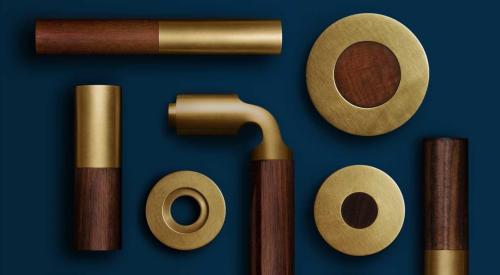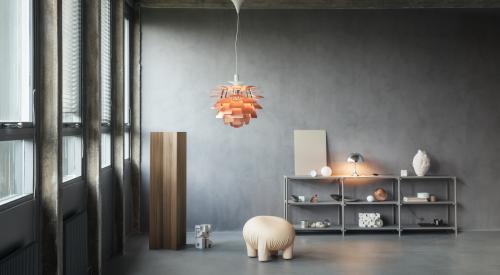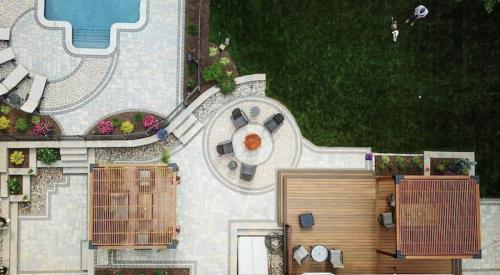Architect Douglas W. Burdge and builder Nate Garnero combined their design skills and experience with repurposing shipping containers to launch a new prefab line called Buhaus.
Both Garnero and Burdge are located in Malibu, Calif., a land of luxury homes and even more luxurious home owners. Burdge has designed over 300 projects in the Malibu region, even taking home several PCBC Gold Nugget Awards throughout his career.
Buhaus comes from the German design movement, Bauhaus, that took an artistic design approach to mass production, carefully combining visually pleasing design with functionality. The “bu” is a reference to Malibu.
[ Read More: PROJECT OF THE WEEK: A SEASIDE RETREAT THAT EMBRACES PASSIVE HOUSE PRINCIPLES ]

Affordable, high-end, off-grid features
The crux of Buhaus is affordable, high-end, high performance shipping container units. Designing a bathroom, eating area, and living space within 160 square feet proved to be difficult, especially when trying to keep the price at $90,000.
“There's a lot of people out there that are trying to build things as quickly and maybe least expensive as possible, maybe even out of a shipping container,” says Burdge. “And so we said, ‘No, let's make a nice unit.’ Let's make nicer finishes. Let's do oak paneling, let's do flooring on a bathroom. Let's have nicer fixtures and plumbing fixtures. Let's make an outdoor shower off the backside. Let's make a Murphy Bed on the inside. Let's make it so it's like the most perfect guest room and the coolest looking guestrooms that you could have in your backyard.”
Buhaus units offer several customization options, but there is a purposeful limit. The exterior can be platinum, black, or “rustern,” which is Burdge’s coined term for rustic modern. The interior can be light oak, warm oak, or black stained. Inside, the Murphy extension can either be a bed or couch, depending on the use of the unit.
“Let's not be difficult,” says Burdge. “Let's give people only a few choices on the inside. When you pick out a car you want, you don't have a million choices. It's simple. You're gonna have cloth or leather, right? You have gray leather or black leather, right? So let's not get complicated.”
All units are turnkey, ready within three to four months. The only thing clients need to figure out are following local jurisdictions by getting the correct permits. Additionally, Buhaus units are set up with off-grid capabilities available through the utility panel, which includes plug-ins for solar panels, water, and sewer connections.
“There's so many different conditions that we get it ready for as many as we can imagine possible,” says Garnero.
[ Read More: PROJECT OF THE WEEK: STEEL STEALS THE SHOW IN MULTI-UNIT CONDO BUILDING ]
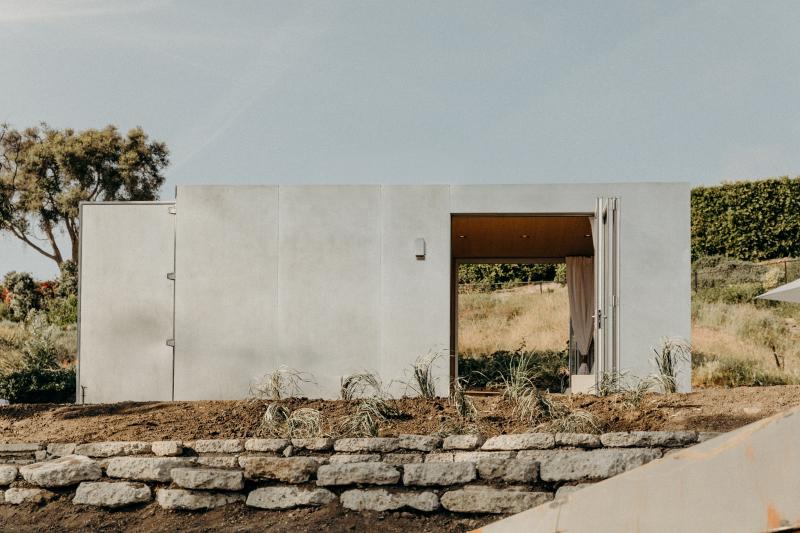
Buhaus beginnings
Six years ago, Garnero was tasked with creating a high-end home consisting entirely of shipping containers for a notable client. The initial project included multiple containers stacked, fitted with the best appliances and features available—not to mention the multi-million dollar price tag. This opened his eyes to the possibilities of high-end shipping container offerings.
“Doug and I are sitting there going, ‘These are genius. How can we make these more affordable but use these kind of high-end finishes?’” says Garnero. “The nice oak, the cladding on the outside, the Corian, the seamless walls in the bathroom. All the things that you see in one of Doug's homes or the homes I build, or these containers that I've been building for clients. And so we sat down and said, ‘This is too good to not try to make a business.’”
They rolled out their first creation at two California design shows: Modernism Week and WestEdge Design Fair. The reactions from fellow designers and builders were nothing like the pair predicted. Initially, Burdge and Garnero believed Buhaus would remain within their realm of clients. Reactions from the shows proved to the duo that the demand for high-end guest rooms or office units was bigger than they imagined.
“[Modernism Week] was wild,” says Burdge. “A wild show that was amazing people walking through, and they just couldn't believe it. That's when we really started ramping up people, from hearing about it and seeing it in person.”
The organizers of Modernism Week decided to place Buhaus’ unit on full display near the show’s entrance, allowing for the maximum amount of eyes on the project. In turn, not only did they receive orders, but valuable feedback to improve the model.
[ Read More: PROJECT OF THE WEEK: A NEW YORK CONDO BUILDING WITH HOTEL-LIKE FEATURES ]
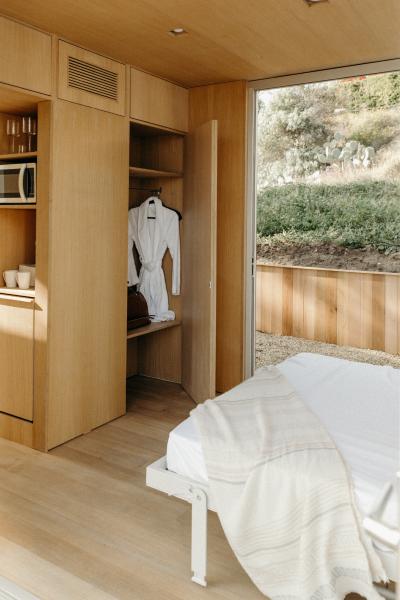
Progressive building techniques
The shipping container is a “high-boy,” meaning it is a taller container reaching up to 8 feet. These containers are also called a “one-trip unit” where they are purchased off a dock in California and have only made a single one-way trip so far. This saves money and resources by purchasing an already used container instead of ordering an entirely new one.
Transportation from the sourced location is easy due to a shipping container's obvious first priority: to be shipped. This translates nicely to transportation to the various locations across the country, or world, where Buhaus may be placed. It also benefits owners who may want to pick their unit up and move it with them to their next home.
For the first few units, Garnero and Burdge used off-the-shelf appliances and hardware. As Buhaus’ reputation grew, designers wanted in. “It evolved when people started hearing about it,” says Garnero. “And they said, ‘We want to be a part of it. We have a better thing. Can you look at our system?’”
Such changes included ditching the Murphy Beds brand and transitioning to Italian-designed Resource Furniture. The look of the units remained the same, but the functionality and ease of use improved.
When searching for luxury yet affordable fixtures and hardware, the duo had a hard time finding exactly what they needed. They dreamed of a high-end gooseneck, single-hole faucet for the bathroom. Local manufacturer Phylrich had no offerings meeting their criteria, but offered to make Buhaus its own line of bathroom fixtures.
Hardware manufacturer Buster + Punch did the same. Instead of Lutron lighting in all units, clients can choose a premium upgrade that comes with custom Buster + Punch lighting.
Bathrooms are fitted with Corian all-white finishes, and a Kohler vanity and medicine cabinet.
Burdge appreciated Garnero’s forward-thinking construction techniques, and the pair chose materials that could create a comfortable atmosphere inside.
“We don't want to use drywall,” says Burdge. “So we wanted to use wood. When you're using wood, you put it on the ceiling, the walls, the floor, so every surface is wood. When you use wood, it helps to make it more intimate. It brings it down.”
The most standout modern building practice Garnero utilized was building a passive-style envelope around the unit. By adding a second layer and creating space between the exterior cladding and interior, heat can escape but also be absorbed. All Buhaus units are fire-resistant due to the metal exterior, aluminum, and glass windows.
[ Read More: PROJECT OF THE WEEK: HYDRAULIC GARAGE DOOR ADDS LIGHT, SPACE TO A GUEST HOUSE ]
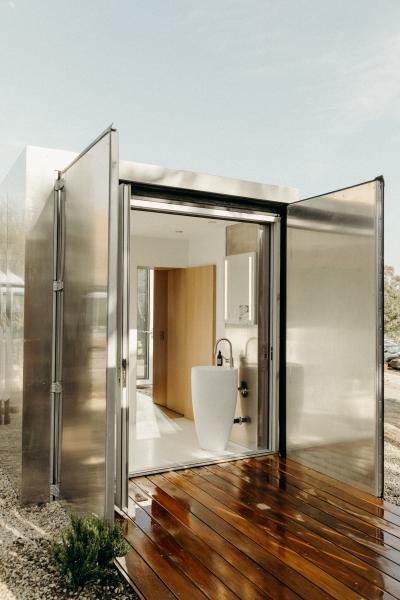
Molding with the times
At the point of inception, Buhaus units were to be functional, stylish guest houses. As COVID-19 reared its ugly head during the roll out, Garnero and Burdge adapted to consumer interests. The Buhaus office became a new focus out of the transition many clients have made toward remote work.
“For people that want a little cheaper unit that's more office space that they can put in their backyard and get out of kids’ orange juice spilling on their dining room table, on their paperwork type thing,” says Garnero. “So we've kind of revamped it, organized the company, [and] slowed production where we can focus on a couple of these [office] units.”
The office unit retains the same shell, size, and shape of the previous Buhaus units but by removing the luxury shower, the pair was able to open the main room to allow for a full workspace. Some elements, such as the pull down sofa and bed, still come with the unit though.
With the addition of the office units, Garnero predicts finishing 100 Buhaus units by the end of 2020. Much of that production volume is already in the works, with orders coming in from Seattle to the Caribbean.
